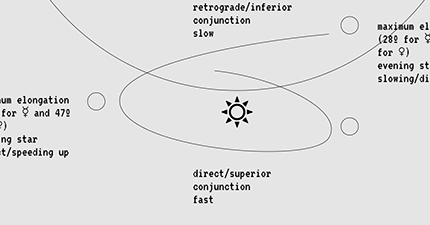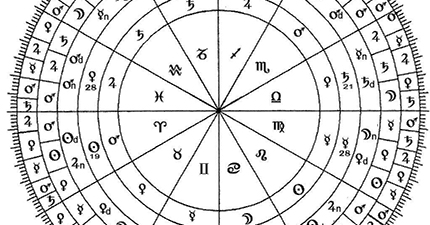Antiscia
Signs that oppose one another across the solstice line are called antiscia, which means opposite shadows.
Signs are considered antiscia when they mirror one another in terms of how much sunlight and moonlight are available during their solar seasons. For example, Cancer sends its antiscion into Gemini because the summer solstice happens at the beginning of Cancer season and the end of Gemini season. Thus, the duration of the day when the Sun is at 1º Cancer (the first day of Cancer season) should be approximately equal to the duration of the night when the Sun is at 29º Gemini (the last day of Gemini season). The same thing is true for Aries and Virgo—the length of the day when the Sun is at 1º Aries is equal to the length of the night when the Sun is at 29º Virgo.
It is important to note that, while some astrologers have written that planets in signs which send and receive antiscion, are at the same declination (the same distance away from the ecliptic based on that z-axis which is invisible on a typical 2-d natal chart), this is not true because all planets have a differently shaped orbit around the Sun. When you look to see whether two planets are sending antiscion in your own chart, for example, they wouldn’t be at the same declination (or distance from the ecliptic) since their orbits would be different. If you don’t want to think about your chart in three dimensions, don’t worry about this for now. I’ll show you what I’m talking about later in this article.
Antiscion signs are said to be confronting signs. Plotemy writes that, because the day and night durations of signs sending antiscion mirror one another, that they are equal to one another in power. Firmucus writes that signs in aspect by antiscia should be considered together when looking at transits in the same way you might consider all the planets that a planets undergoing a transit has conjunctions, oppositions, squares, trines, or sextiles to. William Lily writes that signs sending antiscion should be compared to the beneficial aspects such as trine or sextile.
Contra-antiscia
In contrast, signs that oppose one another across the equinox line are considered to be perceiving signs and counter-antiscia. Contra-antiscia signs can be calculated the same way, by looking for points which are directly opposite to one another across the equinox line. Or, you can simply find a planet’s contra-antiscia by finding the point directly opposite its antiscion point. For example, if 1º Aries sends 29º Virgo antiscion, then it sends 29º Pisces contra-antiscia. 29º Pisces is directly opposite 1º Aries along the equinox line. It is also directly oppositional to 29º Virgo.
Manlius, along with other Greek and Roman astrologers, writes that contra-antiscia, or perceiving signs, are able to hear one another. Lily says that contra-antiscion signs can be compared with the maleficent angles, such as the square and opposition. Plotemy considers contra-antiscion signs as commanding or obeying. Commanding signs, Aries through Virgo, have days that are longer in duration than nights. Obeying signs, Libra through Pisces, have longer length nights than days.
A quick and easy way to calculate antiscia
Here are the signs that send and receive antiscia to and from one another:
Cancer—Gemini
Leo—Taurus
Virgo—Aries
Libra—Pisces
Scorpio—Aquarius
Sagittarius—Capricorn
If you have any planets or points in signs in antiscion, look at the degrees and minutes. Pick one planet. Whatever degree they are, subtract that number from 30 (there are 30º in a sign). Whatever minute they are, subtract that number from 60 (there are 60º minutes in a degree). Write this number down so that the degree based calculation becomes the degree and the minute based calculation becomes the minute. For example, if you got 20 in your first calculation and 35 in your second, then you’re looking for a planet at 20 degrees and 35 minutes (20º35’).
Then, check to see if the planet or point in the sign that your first planet sends antiscia to are at or less than one degree away from the degree and minute that you just calculated.
Here is an example:
Say, you have a planet in 3º26’ Libra. 30 minus 3 is 27. 60 minus 26 is 34. The sign that Libra sends antiscion to is Pisces. Thus, you would be looking to see if you have a planet or point at 27º34’ Pisces. If you have something less than one degree away from 27º34’ Pisces, then congrats! You have two planets that send antiscion to each other.
A quick and easy way to calculate contra-antiscia
Here are the signs that send and receive antiscia to and from one another:
Aries—Pisces
Taurus—Aquarius
Gemini—Capricorn
Cancer—Sagittarius
Leo—Scorpio
Virgo—Libra
You might notice, again, that signs send contra-antiscion to the signs that are directly oppositional to the signs that they send antiscion to. In the chart above, take note that the signs on the left side are the commanding signs and the signs on the right are the obeying signs. Thus, Aries commands Pisces. Likewise, Libra obeys Virgo.
To calculate contra-antiscia, simply do the same calculation. Say you have your moon at 14º59’ Cancer. 30 minus 14 is 16 and 60 minus 59 is 1. The sign that Cancer sends contra-antiscion to is Sagittarius. Thus, anything less than one degree at 16º01’ Sagittarius is receiving contra-antiscion from your moon. Since Cancer is the commanding sign, then your moon is said to command whatever is at 16º01’ Sagittarius.
The easiest way to look at both antiscia and contra-antiscia is to do the calculations once and to look both ways across the sign axis. If your Mars is at 20º Aquarius, then go ahead and take a look at 10º in both Taurus and Scorpio to look for both sets of relationships.
A deeper look at antiscia and contra-antiscia
Before, we were talking about how signs that send antiscion are equal in power because they’re at the same level. What this means is that those signs, along the ecliptic, are at the same declination degree or have the distance to the celestial horizon.

In this diagram, the white dot is the equinox. That’s the Aries Point, where the declination degree is zero. The solstices are the black points, which have the highest delineation (around 23º or 24º).
The red line connects two points along the ecliptic, or signs, sending antiscion. Let’s say that they are at 13º Leo and 17º Taurus. If you drew a line from 13º Leo to the horizon and another from 17º Taurus to the horizon, represented by the dotted red lines, they would be equal in length.
Contra-antiscia points, on the other hand, represented by the dots connected by the blue line, are at a very different declination degrees. While antiscia shows two points that are relatively equal in power or on the same level, contra-antiscia shows two points that are hierarchical. The points in signs Aries to Virgo overpower or command the points in signs Libra through Pisces.


